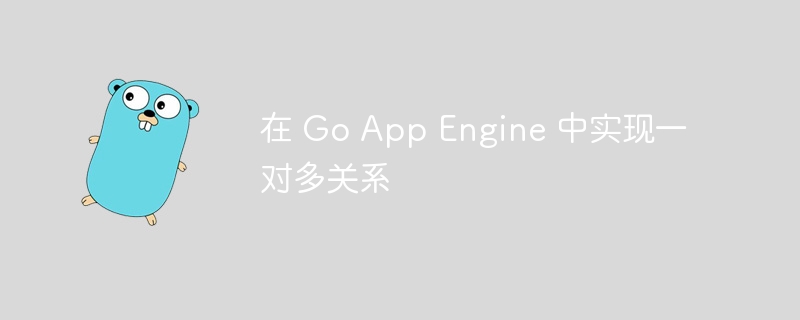GoAppEngine实现一对多关联技巧
时间:2025-08-07 22:45:35 467浏览 收藏
从现在开始,我们要努力学习啦!今天我给大家带来《Go App Engine 实现一对多关系方法》,感兴趣的朋友请继续看下去吧!下文中的内容我们主要会涉及到等等知识点,如果在阅读本文过程中有遇到不清楚的地方,欢迎留言呀!我们一起讨论,一起学习!

本文档介绍了在 Google App Engine 的 Go 语言环境下,如何有效地实现一对多数据关系,例如一个评论对应多个投票。由于 App Engine 数据存储的限制,本文将重点介绍使用 datastore.Key 在实体间建立关联的方法,并提供代码示例演示如何进行查询。
使用 datastore.Key 建立关联
在 App Engine 的 Go 环境中,数据存储对字段类型有严格的限制,不允许直接使用自定义类型或复杂的关联关系。因此,实现一对多关系的关键在于利用 datastore.Key 来建立实体间的引用。
考虑以下场景:一个评论(Comment)可以有多个投票(Vote)。一种常见的错误做法是在 Comment 结构体中存储一个 Vote 的 Key 数组。但 App Engine 有最大 100 个元素的限制,显然无法满足实际需求。
更合理的方案是在 Vote 结构体中存储一个指向 Comment 的 datastore.Key。
type Vote struct {
User string
Score int
CommentKey *datastore.Key
}
type Comment struct {
Author string
Content string
Date datastore.Time
}Vote 结构体中的 CommentKey 字段存储了对应 Comment 实体的 Key。通过这个 Key,我们可以查询所有属于特定 Comment 的 Vote。
查询关联数据
要查询与特定 Comment 关联的 Vote,需要执行以下步骤:
- 获取目标 Comment 实体。
- 使用 Comment 实体的 Key 作为过滤器,查询所有 CommentKey 等于该 Key 的 Vote 实体。
以下代码展示了如何实现这个查询:
package main
import (
"context"
"fmt"
"log"
"os"
"cloud.google.com/go/datastore"
)
type Comment struct {
Author string
Content string
}
type Vote struct {
User string
Score int
CommentKey *datastore.Key
}
func main() {
// Replace with your Google Cloud project ID
projectID := "your-project-id"
// Create a new datastore client.
ctx := context.Background()
client, err := datastore.NewClient(ctx, projectID)
if err != nil {
log.Fatalf("Failed to create client: %v", err)
}
defer client.Close()
// Create a new comment.
comment := Comment{
Author: "John Doe",
Content: "This is a great post!",
}
// Save the comment to the datastore.
commentKey := datastore.NameKey("Comment", "unique-comment-id", nil)
commentKey, err = client.Put(ctx, commentKey, &comment)
if err != nil {
log.Fatalf("Failed to save comment: %v", err)
}
// Create some votes for the comment.
votes := []Vote{
{User: "Alice", Score: 5, CommentKey: commentKey},
{User: "Bob", Score: 4, CommentKey: commentKey},
}
// Save the votes to the datastore.
for _, vote := range votes {
voteKey := datastore.NewIncompleteKey(ctx, "Vote", nil)
_, err = client.Put(ctx, voteKey, &vote)
if err != nil {
log.Fatalf("Failed to save vote: %v", err)
}
}
// Query for all votes for the comment.
query := datastore.NewQuery("Vote").Filter("CommentKey =", commentKey)
var retrievedVotes []Vote
_, err = client.GetAll(ctx, query, &retrievedVotes)
if err != nil {
log.Fatalf("Failed to retrieve votes: %v", err)
}
// Print the retrieved votes.
fmt.Println("Votes for comment:")
for _, vote := range retrievedVotes {
fmt.Printf(" User: %s, Score: %d\n", vote.User, vote.Score)
}
}代码解释:
- 定义结构体: 定义了 Comment 和 Vote 结构体,Vote 包含指向 Comment 的 CommentKey。
- 创建 Datastore 客户端: 使用 datastore.NewClient 创建与 Datastore 交互的客户端。
- 创建并保存 Comment: 创建一个 Comment 实例,并使用 client.Put 方法将其保存到 Datastore。datastore.NameKey 用于创建一个指定名称的 Key。
- 创建并保存 Votes: 创建多个 Vote 实例,并将 CommentKey 设置为之前创建的 Comment 的 Key。使用 datastore.NewIncompleteKey 创建一个不完整的 Key,Datastore 会自动生成唯一的 ID。
- 查询 Votes: 使用 datastore.NewQuery 创建一个查询,并使用 Filter 方法筛选 CommentKey 等于目标 Comment Key 的 Vote 实体。
- 获取查询结果: 使用 client.GetAll 方法执行查询,并将结果存储到 retrievedVotes 切片中。
- 打印结果: 遍历 retrievedVotes 切片,打印每个 Vote 的用户信息和评分。
注意事项:
- 确保替换 your-project-id 为你的 Google Cloud 项目 ID。
- 在实际应用中,需要处理各种错误情况,例如查询无结果等。
- 可以根据实际需求调整查询条件,例如按照用户、评分等进行过滤。
总结
通过在子实体(例如 Vote)中存储父实体(例如 Comment)的 datastore.Key,可以在 App Engine 的 Go 环境中有效地实现一对多关系。这种方法避免了直接存储实体数组的限制,并允许通过查询快速检索关联数据。在实际应用中,需要根据具体场景选择合适的 Key 类型(例如 NameKey 或 IncompleteKey),并注意处理各种错误情况。
今天关于《GoAppEngine实现一对多关联技巧》的内容就介绍到这里了,是不是学起来一目了然!想要了解更多关于的内容请关注golang学习网公众号!
-
505 收藏
-
503 收藏
-
502 收藏
-
502 收藏
-
502 收藏
-
489 收藏
-
296 收藏
-
171 收藏
-
238 收藏
-
156 收藏
-
279 收藏
-
158 收藏
-
191 收藏
-
306 收藏
-
183 收藏
-
313 收藏
-
118 收藏
-

- 前端进阶之JavaScript设计模式
- 设计模式是开发人员在软件开发过程中面临一般问题时的解决方案,代表了最佳的实践。本课程的主打内容包括JS常见设计模式以及具体应用场景,打造一站式知识长龙服务,适合有JS基础的同学学习。
- 立即学习 543次学习
-

- GO语言核心编程课程
- 本课程采用真实案例,全面具体可落地,从理论到实践,一步一步将GO核心编程技术、编程思想、底层实现融会贯通,使学习者贴近时代脉搏,做IT互联网时代的弄潮儿。
- 立即学习 516次学习
-

- 简单聊聊mysql8与网络通信
- 如有问题加微信:Le-studyg;在课程中,我们将首先介绍MySQL8的新特性,包括性能优化、安全增强、新数据类型等,帮助学生快速熟悉MySQL8的最新功能。接着,我们将深入解析MySQL的网络通信机制,包括协议、连接管理、数据传输等,让
- 立即学习 500次学习
-

- JavaScript正则表达式基础与实战
- 在任何一门编程语言中,正则表达式,都是一项重要的知识,它提供了高效的字符串匹配与捕获机制,可以极大的简化程序设计。
- 立即学习 487次学习
-

- 从零制作响应式网站—Grid布局
- 本系列教程将展示从零制作一个假想的网络科技公司官网,分为导航,轮播,关于我们,成功案例,服务流程,团队介绍,数据部分,公司动态,底部信息等内容区块。网站整体采用CSSGrid布局,支持响应式,有流畅过渡和展现动画。
- 立即学习 485次学习
